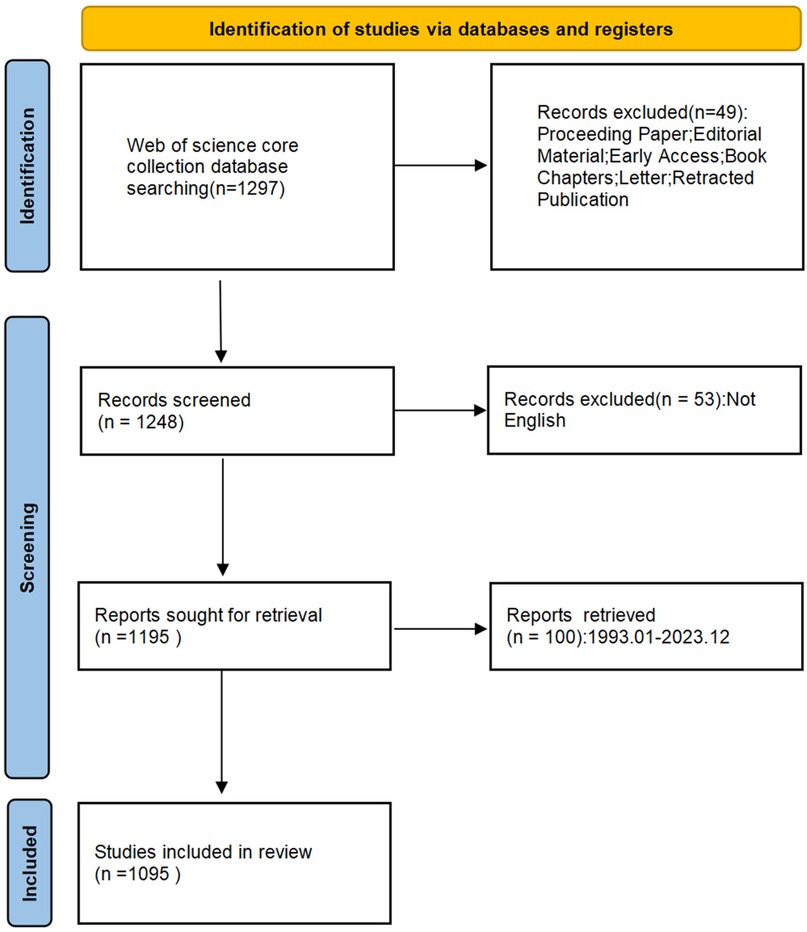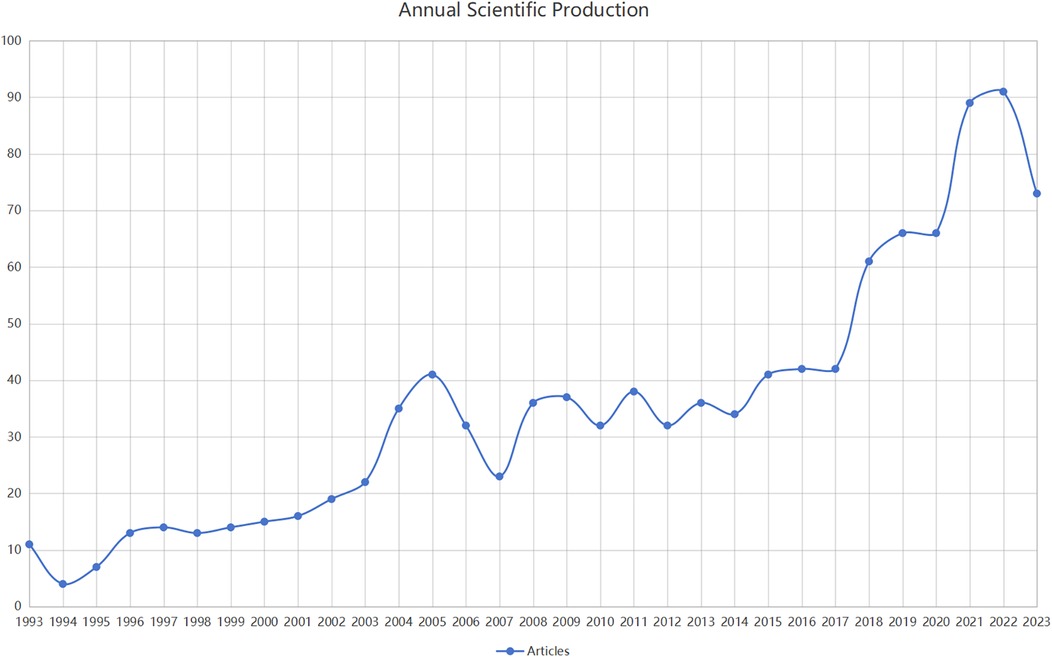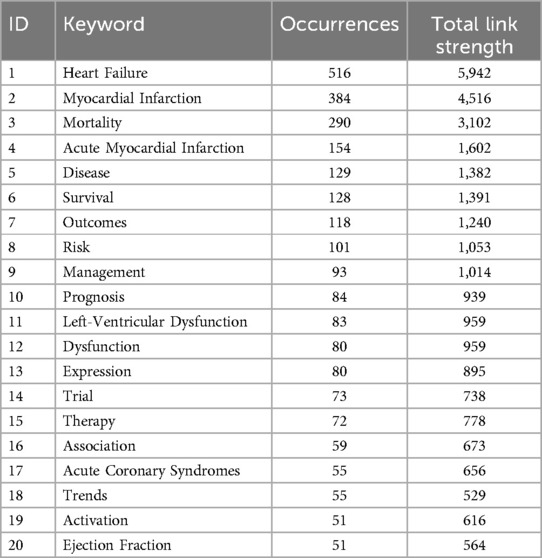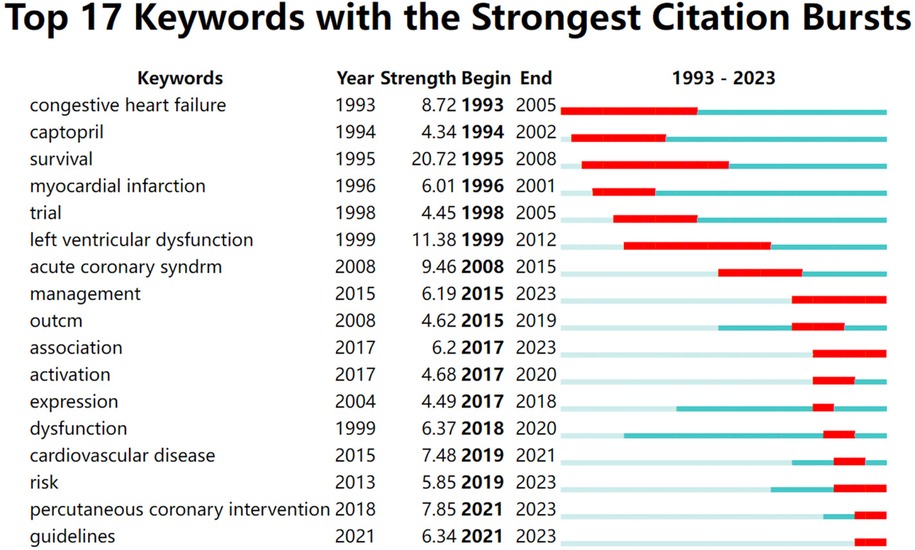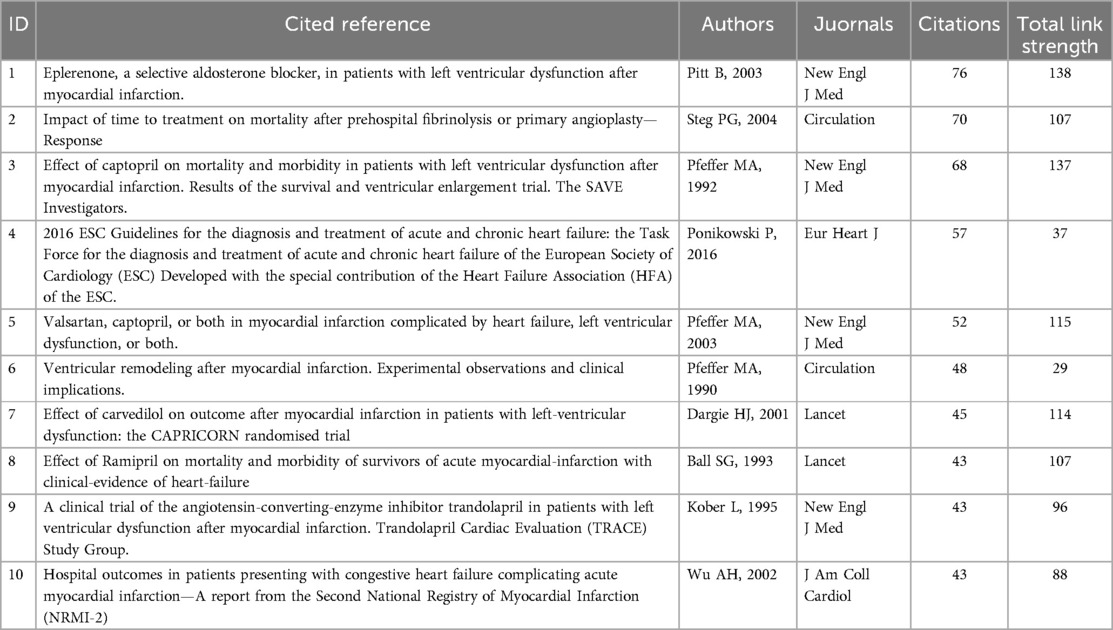- 1Graduate School of Tianjin University of Traditional Chinese Medicine, Tianjin, China
- 2Department of Cardiovascular Medicine, Second Affiliated Hospital of Tianjin University of Traditional Chinese Medicine, Tianjin, China
Background: The incidence of myocardial infarction has been rapidly increasing in recent years, making it one of the most common cardiovascular disorders. Due to the intricate interactions between large-vessel occlusions, microvascular dysfunction, ventricular remodeling, inflammation, and neurohormonal activation, patients who experience myocardial infarction are more likely to develop heart failure. Even though myocardial infarction and heart failure have been studied extensively, a thorough bibliometric analysis has not yet been carried out. The purpose of this study is to use bibliometric analysis to examine the trends in myocardial infarction linked to heart failure during the previous 30 years.
Methods: From 1993 to 2023, this study methodically retrieved original publications from the Web of Science Core Collection (WoSCC) about myocardial infarction and heart failure. We identified research trends and hotspots in the subject by extracting and analyzing data on countries/regions, institutions, authors, journals, keywords, and references related to the issue using tools like CiteSpace and VOSviewer.
Results: Over the past 30 years, there has been a consistent increase in the number of published articles about myocardial infarction and heart failure, reaching a peak in 2022. The United States and China have a significant advantage in publication volume, each exceeding 200 articles. Brigham and Women's Hospital has published the most articles, totaling 49. In addition to publishing the most papers, the journal Circulation also had the biggest influence. The top five keywords include heart failure, myocardial infarction, mortality, acute myocardial infarction, and cardiovascular disease. In recent years, the outbreak words that have remained in the spotlight are management, association, risk, percutaneous coronary intervention, and guidelines.
Conclusion: Over the past 5 years, the increasing incidence of myocardial infarction accompanied by heart failure has garnered significant attention in research, leading to a substantial growth in related literature. The main goal of current research is to clarify the processes through which myocardial infarction causes heart failure; predictions and biomarkers are important areas of study. Future research is likely to concentrate on screening methods and treatment strategies.
1 Introduction
The clinical syndrome known as heart failure (HF) is defined by abnormal structural or functional alterations in the heart due to a variety of causes. Myocardial infarction (MI) is caused by atherosclerotic lesions in the coronary arteries that reduce blood flow, resulting in severe ischemia in the affected myocardium and subsequent necrosis of a portion of the heart muscle. These changes result in impaired ventricular systolic and/or diastolic function, increased cardiac load, decreased cardiac output, elevated pressures in the systemic or pulmonary circulation, and inadequate tissue perfusion. Heart failure, which is linked to a poor prognosis and high mortality, is the most severe and fatal stage of cardiovascular illness.
According to studies, heart failure affects 14%–36% of hospitalized patients with acute myocardial infarction (AMI) and is the primary cause of death among these patients (1). Cardiovascular disease (CVD) remains the leading cause of death in both China and the United States, with AMI and subsequent heart failure as primary contributors (2, 3). Post-infarction, coronary occlusion induces ischemic necrosis of cardiomyocytes, leading to fibrotic scar formation, diminished contractile capacity, and progressive ventricular remodeling—manifested by myocardial fibrosis and hypertrophy—ultimately resulting in heart failure.
The field of bibliometrics uses statistical and mathematical techniques to perform quantitative analysis on scholarly publications. Its primary objective is to uncover patterns in academic research activities, trends in disciplinary development, and the dissemination laws of knowledge by analyzing literature and associated data (such as publications, citations, keywords, etc.). It serves as an impartial and dependable method for assessing the influence and significance of research results. Visualization tools utilize data mining techniques to uncover useful insights and present them from various perspectives. Using the extracted data, knowledge graphs can be developed to assess academic output, identify major research hotspots, and forecast future developments. Over the last 30 years, a significant amount of research has been published on myocardial infarction combined with heart failure, making manual information extraction progressively difficult. Therefore, bibliometric software is essential for systematically summarizing research findings in this domain. CiteSpace and VOSviewer are the most often used bibliometric tools among a variety of software programs. Through three-dimensional visualizations such as Network Visualization, Overlay Visualization, and Density Visualization, VOSviewer makes it possible to visualize networks of collaboration across nations, organizations, and authors. CiteSpace is a data analysis and visualization tool that focuses on time aspects and is founded on set theory. By analyzing time slices via timelines, CiteSpace delves deeper into identifying trends within the field. Furthermore, co-citation analysis and burst detection make it easier to find groundbreaking research and new keywords, giving a thorough picture of the development of the area.
Despite the availability of bibliometric analyses on heart failure, limited studies have focused on myocardial infarction combined with heart failure. This review compiles a total of 1,095 papers published between January 1993 and December 2023 for a comprehensive bibliometric analysis of myocardial infarction in conjunction with heart failure. This review is organized as follows: The data sources and analytical techniques are described in Section 2; the annual publication trends, contributing nations, authors, institutions, and important research topics are covered in detail in Section 3; and the results are compiled in Section 4, which also addresses the state of the field today and its future directions.
2 Methods
2.1 Data source and search strategy
The Web of Science Core Collection (WoSCC) has been chosen as the data source for this investigation. The most prestigious core academic publications in engineering technology, biomedicine, and the natural sciences are all included in WoSCC, the greatest comprehensive academic resource database. By utilizing WoSCC's sophisticated search features, researchers can quickly obtain important scientific data and develop a comprehensive grasp of the subject. The search strategy of this study is “TI = (bibliometrics OR CiteSpace OR VOSviewer) AND TI = (‘heart failure’ OR ‘cardiac failure’ OR ‘heart decompensation’ OR ‘decompensation, heart’ OR ‘myocardial failure’) AND AB = (‘heart failure’ OR ‘cardiac failure’ OR ‘heart decompensation’ OR ‘decompensation, heart’ OR ‘myocardial failure’) AND TI = (‘myocardial infarction’ OR ‘Infarction, Myocardial’ OR ‘Infarctions, Myocardial’ OR ‘Myocardial Infarctions’ OR ‘Heart Attack’ OR ‘Heart Attacks’ OR ‘Myocardial Infarct’ OR ‘Infarct, Myocardial’ OR ‘Infarcts, Myocardial’ OR ‘Myocardial Infarcts’ OR ‘Cardiovascular Stroke’ OR ‘Cardiovascular Strokes’ OR ‘Stroke, Cardiovascular’ OR ‘Strokes, Cardiovascular’) AND AB = (‘myocardial infarction’ OR ‘Infarction, Myocardial’ OR ‘Infarctions, Myocardial’ OR ‘Myocardial Infarctions’ OR ‘Heart Attack’ OR ‘Heart Attacks’ OR ‘Myocardial Infarct’ OR ‘Infarct, Myocardial’ OR ‘Infarcts, Myocardial’ OR ‘Myocardial Infarcts’ OR ‘Cardiovascular Stroke’ OR ‘Cardiovascular Strokes’ OR ‘Stroke, Cardiovascular’ OR ‘Strokes, Cardiovascular’)”. Publication dates ranged from January 1993 to December 2023. Only English-language publications of reviews and articles were included in the search. After 1,095 papers were recovered, the records were exported in tab-delimited file formats and plain text (Figure 1). To minimize data bias, all papers were exported on September 1, 2024.
2.2 Data analysis and visualization methods
CiteSpace 6.3, VOSviewer 1.6.20, the Bibliometrix (R package), and RStudio 4.3.2 were the main bibliometric analytic tools used for the bibliometric and visual knowledge graph analysis of authors, countries, institutions, journals, co-cited references, and keyword bursts. Microsoft Office Excel 2019 was utilized for data management and table creation.
3 Results
3.1 Trend analysis of the number of articles published
From January 1993 to December 2023, WoSCC received a total of 1,297 papers on myocardial infarction combined with heart failure, of which 1,095 articles met the screening criteria. The number of publications per year exhibited a generally increasing trend, as illustrated in Figure 2. Since 2008, the annual publication count has consistently exceeded 30. Notably, there was a minor surge in publications from 2003 to 2005, peaking in 2005, followed by a more substantial increase from 2017 to 2022, with a peak of 91 articles in 2022. This trend indicates growing interest and attention in this field.
3.2 Cooperation network
3.2.1 Country cooperation networks
From January 1993 to December 2023, 74 countries published articles on myocardial infarction combined with heart failure; the United States (USA) was the most productive and influential country, contributing 385 relevant papers that received a total of 26,213 citations, with an average of 68.09 citations per article. Based on the number of publications per country, we were able to identify influential countries in the field and map the network of national collaborations. There is a significant disparity between the USA and other countries in terms of publication output, indicating a pronounced top-tier effect. Collectively, the top 10 countries accounted for the majority of the publications (Table 1).
International collaboration is crucial for advancing this field. Based on the co-occurrence network generated by VOSviewer, the United States, China, Canada, Japan, and the United Kingdom have played key roles. With a threshold of six publications, we created a network graph illustrating national cooperation (Figure 3). In this graph, the size or color of the nodes represents publication volume, and the lines connecting the countries show their collaborations. The thickness and number of these lines reflect the strength of their partnerships. The United States, with a link strength of 419, is central to the network, highlighting its dominant role and influence. The top three countries with the most significant ties to the United States are Canada, Italy, and France. Centrality is used to assess the importance of each country within the international collaboration network. A higher centrality value indicates a more critical role in connecting different countries and facilitating knowledge flow across the entire network. According to the calculation (Figure 3D), the United States has the highest centrality (0.46), suggesting it serves as a key bridge in global research collaboration. France and the United Kingdom also exhibit relatively high centrality values (0.38 and 0.27, respectively), reflecting their significant influence and integrative capacity within the network. These findings highlight the prominent intermediary roles played by a few key countries in shaping the global research landscape.
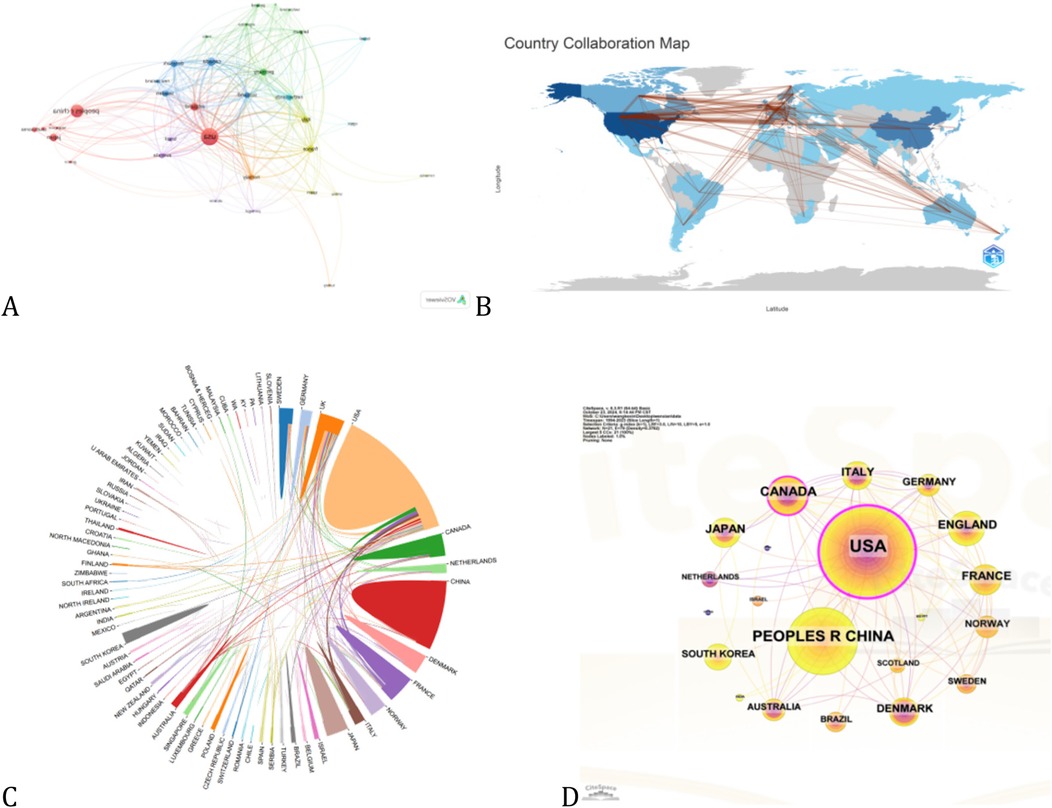
Figure 3. Country cooperation network maps, including (A–D). (A) A Country Collaboration Network Map shows research collaboration between countries. Nodes (circles) represent countries, with larger nodes indicating more active participation in collaborations. Edges (lines) connect countries that have co-authored papers or worked together on research projects, with thicker lines indicating stronger or more frequent collaborations. Colors distinguish collaboration clusters, with each color representing a group of closely connected countries. (B) The World Collaboration Map visually represents international partnerships based on geographic location. Connecting lines indicate collaboration between countries—thicker lines reflect more frequent cooperation. Darker country colors signify higher levels of collaborative activity, such as joint publications or research engagement. (C) The Chord Diagram visually represents bilateral collaboration between countries. Arcs along the outer circle denote individual countries, while connecting chords indicate partnerships—thicker chords reflect stronger ties. Colors distinguish countries and highlight major collaborations. (D) The Collaboration Intensity Network Map illustrates global collaboration strength and structure, highlighting leading countries. Nodes represent countries, with size and text weight indicating total collaboration intensity. Thicker connecting lines show stronger bilateral ties, while color and glow effects emphasize key players.
3.2.2 Author collaboration network
The criterion for core authorship can be expressed as follows: m ≈ 0.749 × (n_max)0.5, where n_max is the number of papers published by the most prolific author and m is the minimum number of papers required for an author to be considered part of the core group. Based on Price's Law, there were 6,291 authors who published papers on myocardial infarction combined with heart failure between January 1993 and December 2023. Authors who have published more than four papers in this field are categorized as core authors, and 85 authors, or 1.35% of the total number of authors (85/6,291).
Four American scholars are among the top 10 most prolific authors (Table 2), highlighting the important role of American researchers in this field. Professor Faiez Zannad of the University of Lorraine wrote 33 papers, with a total link strength of 318 with other researchers. He was the most influential author, with 1,316 total citations and an average citation frequency of 39.88 per paper. Assessing the efficacy of eplerenone in treating patients with myocardial infarction and heart failure is the main focus of Prof. Zannad's research. Figure 4 shows a collaborative network diagram of authors with more than four publications, divided into five clusters overall, with Prof. Faiez Zannad at the center, working closely with 25 co-authors, including Patrick Rossignol and Bertram Pitt as his closest collaborators. Figure 4 highlights that the research group led by Prof. Patrick Rossignol has extensively studied the effects of spironolactone and other inhibitors of the renin-angiotensin-aldosterone system on heart failure patients over the past decade. Additionally, Profs. Harlan M. Krumholz, Lars Kober, and John J.V. McMurray have high H-indexes and average citation frequencies, indicating their leadership in the field.
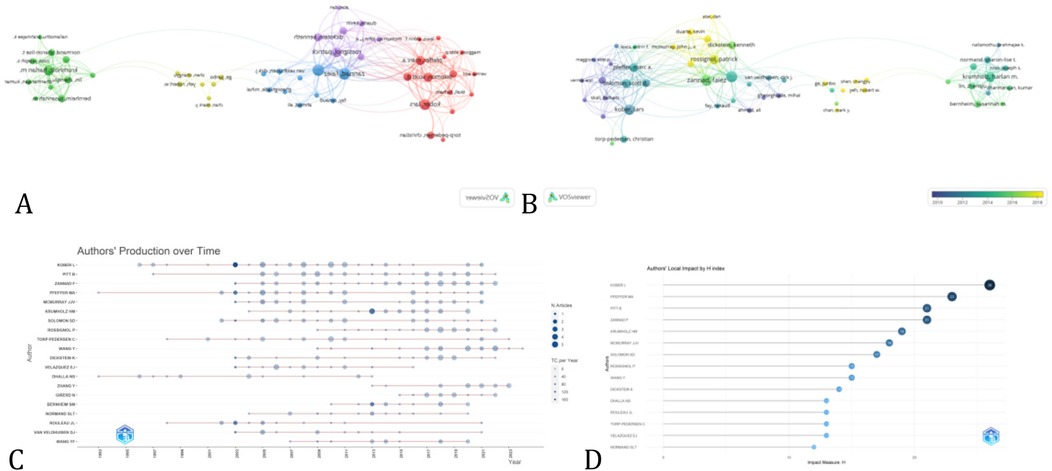
Figure 4. The visualization knowledge maps of author, including (A) network visualization, (B) overlay visualization, and (C) authors’ production over time and (D) authors’ local impact by H index.
3.2.3 Institutional cooperation network
Between January 1993 and December 2023, a total of 1,709 institutions were involved in research related to myocardial infarction combined with heart failure. Among them, Brigham and Women's Hospital stood out with 49 publications, showcasing its notable impact in this area. Five of the top 10 institutions (Table 3) were based in the United States, underscoring the country's leading role in medical research. Figure 5 depicts the collaborative network of the 43 leading contributing institutions. Both the University of Glasgow and Brigham and Women's Hospital have link strengths of 309 and 304, respectively, indicating their strong collaborative ties and prominent positions within the field. Notably, Duke University has the strongest links to both Brigham and Women's Hospital and the University of Glasgow, having published numerous high-quality articles. This suggests that institutional collaborations have significantly advanced the field. Furthermore, Brigham and Women's Hospital, the University of Glasgow, and Duke University are all categorized in the red group, indicating that institutions in this group hold greater influence.
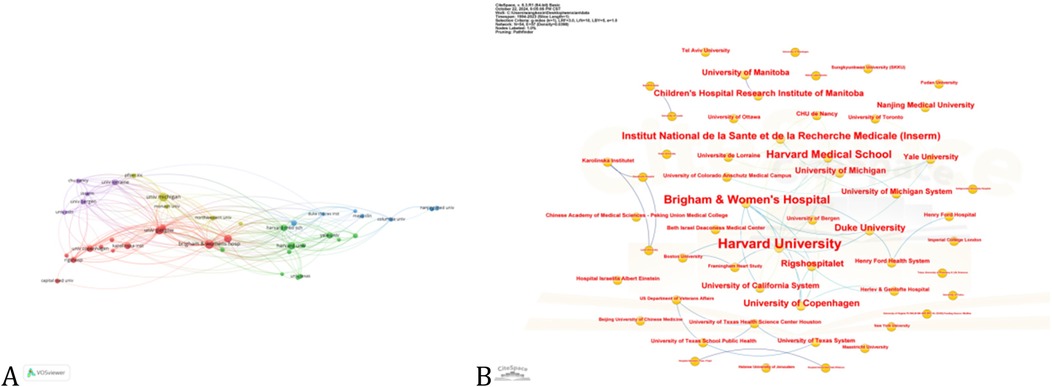
Figure 5. Diagram of the institutional cooperation network. (A) The Institution Collaboration Network Map visualizes research partnerships between institutions. Nodes represent institutions, with larger nodes indicating higher collaboration activity. Edges connect co-authoring institutions, with thicker lines signifying stronger ties. Colors highlight clusters of closely connected institutions. (B) This image shows a collaboration network of research institutions, where each node represents an institution and lines indicate partnerships such as co-authored papers or joint projects. Larger, bolder nodes—like Harvard University and Brigham & Women's Hospital—highlight central institutions with high levels of collaboration.
3.3 Journal analysis
Table 4 lists the 10 journals with the highest publication frequency. Among the 393 journals, the American Journal of Cardiology (IF = 2.3, Q2) ranks first in the number of publications with 63 articles and an average of 32.44 citations per article. The Journal of the American Heart Association (IF = 5.0, Q1) has the highest citation rate with 250.19 citations per article. The European Heart Journal (IF = 37.6, Q1) not only leads in citation frequency but also boasts the highest impact factor, making it one of the most influential journals in cardiovascular research. Circulation (IF = 35.5, Q1) demonstrates a higher impact factor, citation frequency, and H-index relative to other journals. These journals are particularly attractive to researchers due to their high impact factors and substantial contributions to myocardial infarction combined with heart failure.
3.4 Keyword analysis
Keywords represent the core concepts of an article, allowing us to determine the main research directions and hotspots in the field of myocardial infarction combined with heart failure through co-occurrence analysis. A total of 4,058 unique keywords were extracted from 1,095 articles on this topic. Using VOSviewer, a keyword network was constructed, and keywords occurring more than 15 times were visualized (Figure 6). The top five keywords were heart failure, myocardial infarction, mortality, acute myocardial infarction and disease. Bursty keywords, characterized by their high frequency within a short period, were identified using CiteSpace's timeline graph to track the temporal evolution of research in this field. Table 5 shows that keywords such as mortality, survival, outcomes, and risk have appeared more frequently, particularly the term “mortality,” which has seen a significant increase in recent years. This trend suggests that the severity of myocardial infarction combined with heart failure has escalated and garnered considerable attention.
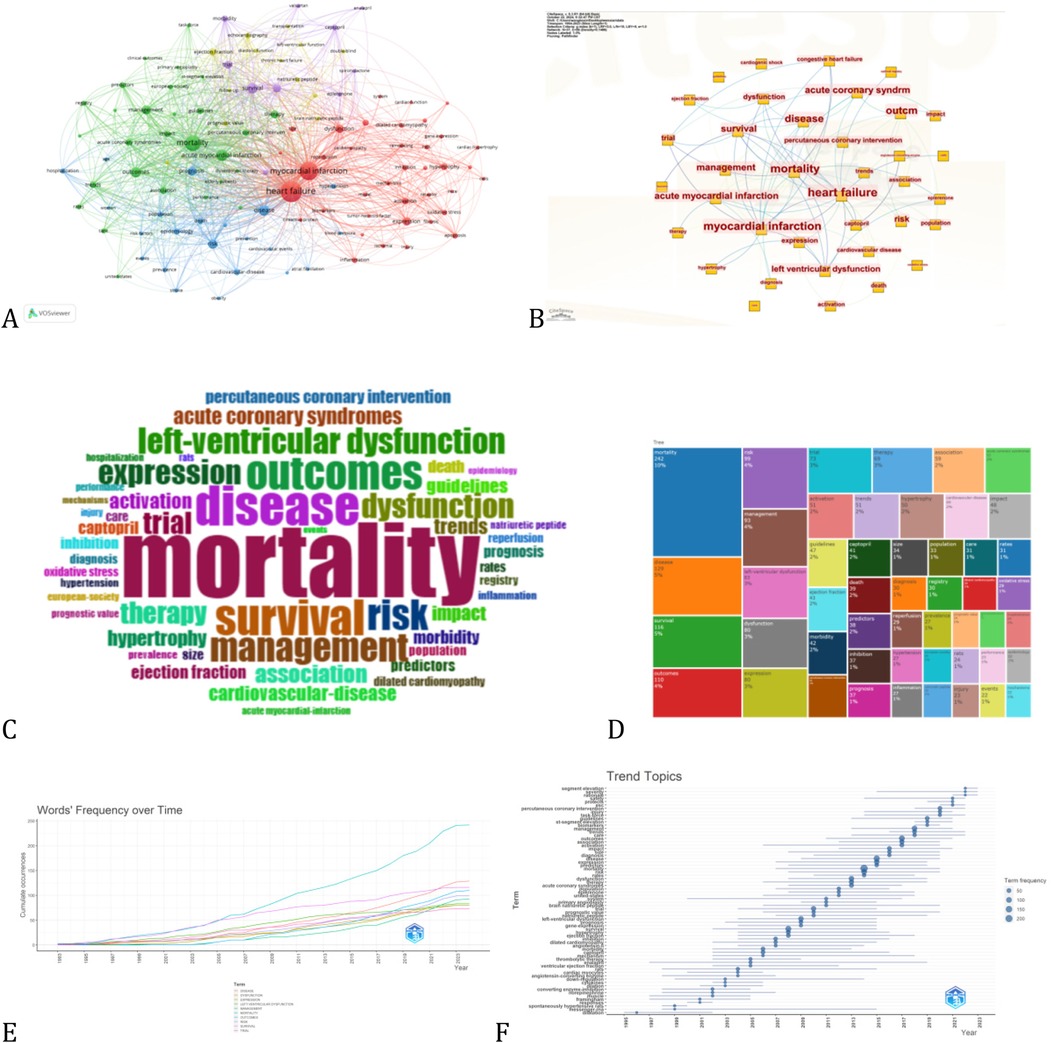
Figure 6. The visualization knowledge maps of keyword, including (A,B) keyword network diagram, (C) wordcloud, (D) treemap, (E) word dynamics, and (F) trend topics.
Over the past three decades, research on myocardial infarction (MI) complicated by heart failure (HF) has evolved from acute, pathophysiology-centered investigations to a comprehensive, multidisciplinary approach to chronic cardiac care. In the early 1990s, clinical trials established the mortality benefits of neurohormonal blockade—particularly with ACE inhibitors such as captopril and ramipril (4). By the late 1990s and 2000s, treatment expanded to include β-blockers, ARBs, and aldosterone antagonists, with increasing emphasis on long-term outcomes and comorbidity management, recognizing that survival was only the beginning. In the 2010s, novel therapies such as ARNIs and SGLT2 inhibitors emerged, informed by a deeper understanding of cardiorenal and metabolic interactions beyond the classical RAAS pathway. At the same time, HF care shifted toward a systems-based model—integrating device therapy, revascularization, and the management of common comorbidities like diabetes and kidney disease. Landmark trials like STICH and REVIVED redefined the role of revascularization in ischemic cardiomyopathy, with STICH demonstrating long-term survival benefits from CABG in patients with impaired LV function. These studies reinforced the importance of individualized treatment strategies.
In the 2020s, the field entered a new phase, shaped by precision medicine and artificial intelligence. Modern research integrates genomics, circulating biomarkers, imaging, and machine learning to refine risk stratification and guide therapy. Bibliometric burst analyses show rising interest in terms such as “inflammation,” “biomarker,” “machine learning,” and “microbiome” (5), highlighting key emerging areas. What began as an effort to prevent adverse remodeling has grown into a diverse, interdisciplinary endeavor spanning molecular biology, bioinformatics, and population health. The evolution of research themes from 1993 to 2023—traced through co-occurrence networks and cluster analyses—shows clear transitions: from ACE inhibitors to ARNIs and SGLT2 inhibitors; from short-term survival to long-term, multimorbidity management; from acute coronary care to chronic HF optimization; from ejection fraction metrics to multi-omics biomarkers; and from traditional trials to AI-driven prediction models. Each progression, anchored in both foundational evidence and cutting-edge science, has deepened our understanding and enhanced the care of MI patients with HF. Today, the field offers a more holistic, precise, and hopeful strategy for a once highly fatal condition.
3.5 Keywords with citation burst
Figure 7 shows the top 17 keywords with the strongest citation bursts. The keywords of “congestive heart failure” (1993–2005), “captopril” (1994–2002), “survival” (1995–2008), “left ventricular dysfunction” (1999–2012) presented as hotspots for a long period in the past; whereas “management” (2015–2023), “risk” (2019–2023), “guidelines”(2021–2023) and “percutaneous coronary intervention (2021–2023)” have been used more recently, which indicate the future hotspots in the research field of myocardial infarction combined with heart failure.
3.6 Analysis of co-cited references
A co-cited reference arises when two or more articles are cited together by the same article or group of articles. Given that the co-citation relationships among literature evolve over time, analyzing co-cited references can provide insights into the developmental and evolutionary dynamics of a field. Co-citation analysis facilitates the identification of seminal works within the field. We established a threshold of 17 and identified 71 co-cited references (Figure 8). Table 6 highlights the ten most co-cited references. Notably, the articles ranked 8th and 5th have the highest individual citation counts, with 1,895 and 1,770 citations respectively, indicating their significant influence in the field.

Figure 8. The visualization of co-citation reference, including (A) network visualization and (B) density visualization.
4 Discussion
This study conducted a bibliometric analysis of myocardial infarction combined with heart failure spanning the years 1993–2023. We utilized software such as CiteSpace, VOSviewer, and RStudio to quantitatively visualize the evolution and research hotspots in this field. The results reveal a notable rise in the number of publications over the past three decades. We then carried out a comprehensive quantitative analysis of various factors, such as countries, authors, institutions, journals, keywords, and references. The United States stood out as the most productive and influential country in this field, maintaining strong collaborations with other nations. U.S. institutions ranked high in both the volume and quality of publications. Notably, authors with the highest publication counts are predominantly from the United States, France, Denmark, and other countries. Among them, Prof. Faiez Zannad from the University of Lorraine, France, has the highest publication count, the strongest collaboration links, and is considered one of the most influential authors. In terms of journals, CIRCULATION stands out as one of the most influential in this field, boasting a high volume of publications, impact factor, average citation frequency, and H-index. Furthermore, the analysis of emerging terms indicates that future research is likely to focus on the screening and treatment of myocardial infarction combined with heart failure. Finally, through co-citation analysis, we identified key classic literature in this field.
Post-myocardial infarction (MI) heart failure (HF) remains a major clinical challenge, driven by complex molecular and cellular mechanisms. Central to its development is adverse left ventricular remodeling, which begins with widespread cardiomyocyte necrosis/apoptosis and compensatory hypertrophy, followed by excessive extracellular matrix deposition (fibrosis), ultimately impairing cardiac function. The initial ischemic insult activates a sterile inflammatory response via damage-associated molecular patterns (DAMPs), engaging innate immune pathways such as Toll-like receptors and inflammasomes. These trigger nuclear factor-κB (NF-κB) activation and the release of inflammatory cytokines like IL-1β, IL-6, and TNF-α (6). Although essential for clearing necrotic tissue, sustained inflammation aggravates myocardial damage and remodeling. Proteomic analysis in post-MI HF patients has highlighted differentially expressed proteins linked to the NF-κB pathway, emphasizing its central role in disease progression (7). NF-κB–driven gene expression promotes cytokines, chemokines, and matrix metalloproteinases that exacerbate tissue injury, while experimental NF-κB inhibition alleviates remodeling in animal models.
In parallel, neurohormonal activation—particularly via the renin–angiotensin–aldosterone system (RAAS)—contributes significantly to HF. Angiotensin II drives vasoconstriction, hypertrophy, and fibroblast activation, whereas ACE2 exerts a counter-regulatory effect by degrading Ang II into the protective Ang-(1–7) peptide. Under ischemic conditions, Chen et al. (8) found that p38 MAPK-mediated activation of ADAM17 leads to ACE2 shedding, removing its cardioprotective role and intensifying RAAS-mediated fibrosis and hypertrophy. ADAM17 upregulation correlates with increased infarct size and worse remodeling, while its inhibition improves cardiac outcomes in mice. Moreover, ADAM17 enhances inflammation by cleaving cytokine precursors and receptors (e.g., pro-TNF-α, IL-6R), reinforcing its role as a molecular driver of post-MI HF.
During the healing phase, TGF-β–induced activation of cardiac fibroblasts results in scar formation. While necessary for structural integrity, excessive or diffuse fibrosis increases ventricular stiffness and promotes HF, even with preserved ejection fraction. Recent transcriptomic studies have identified four key genes (KLRC2, SNORD105, SNORD45B, RNU5A-1) linked to post-MI HF, suggesting immune dysregulation involvement. Non-coding RNAs, particularly microRNAs, also regulate remodeling: let-7c promotes fibrosis and apoptosis, whereas let-7i suppresses inflammation and collagen production. Dysregulation of these miRNAs can drive maladaptive remodeling, and their therapeutic modulation has shown promise in reducing fibrosis and improving function in preclinical models.
Predictors, predictive models, and biomarkers of heart failure (HF) in combination with myocardial infarction have garnered significant research attention in recent years. A study identified two potential immune-related hub genes (IRHGs), CXCR5 and FOS, through a bioinformatics approach. Functional enrichment analysis showed that these IRHGs were closely associated with immune system processes, particularly the interleukin-17 and nuclear factor-κB signaling pathways, which are critical in HF pathogenesis. The study demonstrated that these two IRHGs were differentially expressed in the HF group and could serve as predictors of heart failure after long-term myocardial infarction (9). Another study recognized serum high-mobility group box 1 (HMGB1) as a biomarker for acute myocardial infarction with heart failure (10). Additionally, RT-qPCR analysis identified FOS, DUSP1, CXCL8, and NFKBIA as potential biomarkers for identifying AMI patients at risk of developing HF (11). Moreover, another study revealed that combining glycan antigen 125 with N-terminal B-type natriuretic peptide precursor enhanced the prediction of acute heart failure following ST-segment elevation myocardial infarction (12).
The treatment of myocardial infarction combined with heart failure remains a relatively underexplored area. Western medicine primarily relies on traditional anti-coronary drugs aimed at improving ventricular remodeling, such as sacubitril/valsartan and ACEI/ARB. Recently, research into traditional Chinese medicine has gained attention. For instance, the Xin-Li formula has been shown to alleviate heart failure caused by hyperlipidemia and myocardial infarction in rats through Treg immunomodulation and inhibition of the NLRP3 inflammasome (13). Similarly, Linggui Zhugan decoction delays ventricular remodeling in rats with chronic heart failure after myocardial infarction via the Wnt/β-catenin signaling pathway (14), and Nuanxinkang prevents chronic heart failure induced by myocardial infarction by enhancing PINK1/Parkin-mediated mitophagy (15). However, most of these studies are still limited to animal models. Research on therapeutic protein targets has also progressed alongside advances in cardiovascular disease understanding. For example, C1q/tumor necrosis factor-related protein 12 (CTRP12) has been found to reduce heart failure after myocardial infarction by modulating the TAK1-p38 MAPK/JNK signaling pathway, suggesting its potential as a therapeutic target for post-MI heart failure (16). Additionally, the apelin receptor (APJ), a widely expressed G protein-coupled receptor, holds promise as a therapeutic target for peptide analogs in treating myocardial infarction and hypertension-induced heart failure (17).
Studies have identified several drugs and their components that exhibit therapeutic effects on myocardial infarction combined with heart failure. For example, levosimendan has demonstrated effectiveness in enhancing cardiac function, improving hemodynamics, and reducing systemic inflammation in patients with acute myocardial infarction and heart failure (18). Resveratrol, a diphenylethylene polyphenol, exhibits beneficial biological properties against chronic diseases. Recent evidence suggests that resveratrol provides cardioprotective effects in animal models of atherosclerosis, ischemic heart disease, and heart failure (19).
5 Limitation
This study has several limitations: First, although WoSCC is the most widely used search database, some relevant articles might still have been missed. Second, the continuous updating of the database introduces a time lag in the data, including metrics like article counts, citation numbers, and H-index values. Third, variations in the quality of the collected articles may affect the reliability of the findings.
6 Conclusion
This study conducted a systematic review of 1,095 papers published from January 1993 to December 2023, highlighting research progress, key topics, and trends in myocardial infarction combined with heart failure. Over the last three decades, substantial progress has been achieved in understanding the factors influencing this condition, its epidemiology, and its adverse clinical outcomes. Future studies should prioritize exploring the mechanisms of comorbidities and developing effective interventions.
Data availability statement
The original contributions presented in the study are included in the article/Supplementary Material, further inquiries can be directed to the corresponding author.
Author contributions
KW: Data curation, Visualization, Writing – original draft. SZ: Writing – review & editing. MZ: Writing – review & editing.
Funding
The author(s) declare that no financial support was received for the research and/or publication of this article.
Conflict of interest
The authors declare that the research was conducted in the absence of any commercial or financial relationships that could be construed as a potential conflict of interest.
Generative AI statement
The author(s) declare that no Generative AI was used in the creation of this manuscript.
Any alternative text (alt text) provided alongside figures in this article has been generated by Frontiers with the support of artificial intelligence and reasonable efforts have been made to ensure accuracy, including review by the authors wherever possible. If you identify any issues, please contact us.
Publisher's note
All claims expressed in this article are solely those of the authors and do not necessarily represent those of their affiliated organizations, or those of the publisher, the editors and the reviewers. Any product that may be evaluated in this article, or claim that may be made by its manufacturer, is not guaranteed or endorsed by the publisher.
Supplementary material
The Supplementary Material for this article can be found online at: https://www.frontiersin.org/articles/10.3389/fcvm.2025.1555748/full#supplementary-material
References
1. Akhtar KH, Khan MS, Baron SJ, Zieroth S, Estep J, Burkhoff D, et al. The spectrum of post-myocardial infarction care: from acute ischemia to heart failure. Prog Cardiovasc Dis. (2024) 82:15–25. doi: 10.1016/j.pcad.2024.01.017
2. Tsao CW, Aday AW, Almarzooq ZI, Anderson CAM, Arora P, Avery CL, et al. Heart disease and stroke statistics-2023 update: a report from the American heart association. Circulation. (2023) 147(8):e93–621. doi: 10.1161/CIR.0000000000001123
3. Zhu Y, Wang Y, Shrikant B, Tse LA, Zhao Y, Liu Z, et al. Socioeconomic disparity in mortality and the burden of cardiovascular disease: analysis of the prospective urban rural epidemiology (PURE)-China cohort study. Lancet Public Health. (2023) 8(12):e968–77. doi: 10.1016/S2468-2667(23)00244-X
4. Swaroop G. Post-myocardial infarction heart failure: a review on management of drug therapies. Cureus. (2022) 14(6):e25745. doi: 10.7759/cureus.25745
5. Fang Y, Wu Y, Gao L. Machine learning-based myocardial infarction bibliometric analysis. Front Med. (2025) 12:1477351. doi: 10.3389/fmed.2025.1477351
6. Papamichail A, Kourek C, Briasoulis A, Xanthopoulos A, Tsougos E, Farmakis D, et al. Targeting key inflammatory mechanisms underlying heart failure: a comprehensive review. Int J Mol Sci. (2023) 25(1):510. doi: 10.3390/ijms25010510
7. Liu Y, Huang D, Li Z, Zhou L, Cen T, Wei B, et al. A plasma proteomic approach in patients with heart failure after acute myocardial infarction: insights into the pathogenesis and progression of the disease. Front Cardiovasc Med. (2023) 10:1153625. doi: 10.3389/fcvm.2023.1153625
8. Chen Q, Li Y, Bie B, Zhao B, Zhang Y, Fang S, et al. P38 MAPK activated ADAM17 mediates ACE2 shedding and promotes cardiac remodeling and heart failure after myocardial infarction. Cell Commun Signal. (2023) 21(1):73. doi: 10.1186/s12964-023-01087-3
9. Hu Y, Chen X, Mei X, Luo Z, Wu H, Zhang H, et al. Identification of diagnostic immune-related gene biomarkers for predicting heart failure after acute myocardial infarction. Open Med. (2023) 18:20230878. doi: 10.1515/med-2023-0878
10. Wahid A, Wen J, Yang Q, Zhang Z, Zhao X, Tang X. Serum HMGB1 is a biomarker for acute myocardial infarction with or without heart failure. Clin Transl Sci. (2023) 16:2299–309. doi: 10.1111/cts.13630
11. Liu W, Li Y, Zhang Y, Li S, Chen Y, Han B, et al. Identification of biomarkers and immune infiltration in acute myocardial infarction and heart failure by integrated analysis. Biosci Rep. (2023) 43:BSR20222552. doi: 10.1042/BSR20222552
12. Xu K, Wu M, Huang M, Zhuo X, Weng Y, Chen X. Carbohydrate antigen 125 combined with N-terminal pro-B-type natriuretic peptide in the prediction of acute heart failure following ST-elevation myocardial infarction. Medicine. (2022) 101:e32129. doi: 10.1097/MD.0000000000032129
13. Lan T, Zeng Q, Zhu Y, Zheng G, Chen K, Jiang W, et al. Xin-Li formula attenuates heart failure induced by a combination of hyperlipidemia and myocardial infarction in rats via Treg immunomodulation and NLRP3 inflammasome inhibition. J Tradit Complement Med. (2023) 13:441–453. doi: 10.1016/j.jtcme.2023.03.009
14. Yang M, Wu H, Qian H, Li D, Xu H, Chen J, et al. Linggui Zhugan decoction delays ventricular remodeling in rats with chronic heart failure after myocardial infarction through the wnt/β-catenin signaling pathway. Phytomedicine. (2023) 120:155026. doi: 10.1016/j.phymed.2023.155026
15. Guan Z, Chen J, Wang L, Hao M, Dong X, Luo T, et al. Nuanxinkang prevents the development of myocardial infarction-induced chronic heart failure by promoting PINK1/Parkin-mediated mitophagy. Phytomedicine. (2023) 108:154494. doi: 10.1016/j.phymed.2022.154494
16. Bai B, Ji Z, Wang F, Qin C, Zhou H, Li D, et al. CTRP12 ameliorates post-myocardial infarction heart failure through down-regulation of cardiac apoptosis, oxidative stress and inflammation by influencing the TAK1-p38 MAPK/JNK pathway. Inflamm Res. (2023) 72:1375–1390. doi: 10.1007/s00011-023-01758-4
17. Rossin D, Vanni R, Lo Iacono M, Cristallini C, Giachino C, Rastaldo R. APJ as promising therapeutic target of peptide analogues in myocardial infarction- and hypertension-induced heart failure. Pharmaceutics. (2023) 15:1408. doi: 10.3390/pharmaceutics15051408
18. Sun X, Wei C, Li L, Qu C. Levosimendan improves cardiac function, hemodynamics, and body inflammation in patients with acute myocardial infarction and heart failure. Am J Transl Res. (2023) 15:5624–32.37854215
Keywords: myocardial infarction, heart failure, bibliometrics, CiteSpace, VOSviewer
Citation: Wang K, Zhang S and Zhu M (2025) Bibliometric study and visualization of myocardial infarction combined with heart failure, 1993–2023. Front. Cardiovasc. Med. 12:1555748. doi: 10.3389/fcvm.2025.1555748
Received: 5 January 2025; Accepted: 25 July 2025;
Published: 8 August 2025.
Edited by:
Muwei Li, Fuwai Central China Cardiovascular Hospital, ChinaCopyright: © 2025 Wang, Zhang and Zhu. This is an open-access article distributed under the terms of the Creative Commons Attribution License (CC BY). The use, distribution or reproduction in other forums is permitted, provided the original author(s) and the copyright owner(s) are credited and that the original publication in this journal is cited, in accordance with accepted academic practice. No use, distribution or reproduction is permitted which does not comply with these terms.
*Correspondence: Shaoqiang Zhang, dGp6eXpzcUAxNjMuY29t
 Kexin Wang
Kexin Wang Shaoqiang Zhang2*
Shaoqiang Zhang2* Mingdan Zhu
Mingdan Zhu